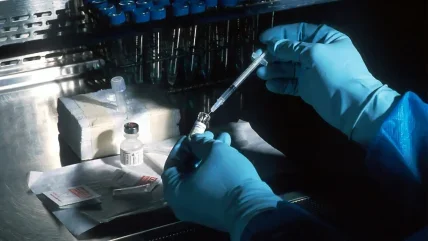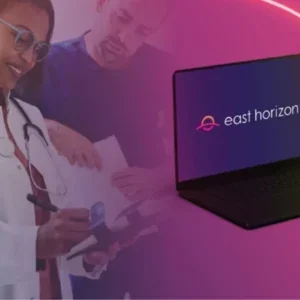
The use of proteins and peptides in therapeutics has increased greatly over the past few decades, owing to multiple applications in the clinic. The categories themselves simply refer to large molecules that form the fundamental components of cells, while the differences between them relate to their size and structure. Proteins are the larger of the two, comprised of between 50 and 100 amino acids. Peptides, on the other hand, tend to have about 20.
“Proteins and peptides are regarded as excellent drugs because they work very specifically as therapies in low concentrations, and they don’t have a lot of side effects compared with smaller molecules,” explains David Brayden, professor of advanced drug delivery at University College Dublin. “I’d include antibodies too, because they’re just larger proteins.”
Fairly early in the Covid-19 pandemic, monoclonal antibodies (MABs) – synthetic proteins that act like human antibodies in the immune system – were identified as a potential treatment, and are now even used as a preventative measure in high-risk patients. Only one such product broke through into the clinic prior to the 1990s – but the number being used clinically has now reached 100.
This, alongside the fact that one in every three clinical trials now involves peptides or proteins, drives home just how much the field has evolved.
The oral barrier
This success has primarily related to injectable versions of peptides, proteins and antibodies, with around eight in ten therapies delivered subcutaneously and the remainder via IV. But neither of these methods is ideal when it comes to patient comfort, which is why the major challenge faced by researchers has been, and continues to be, overcoming poor bioavailability in oral protein and peptide delivery.
One benefit that could result from translating the advancements made with parenteral methods to oral delivery is medication adherence. According to a review published in the Annals of Internal Medicine, one in five patients don’t even f–ill their prescriptions and half of all patients with chronic conditions fail to take treatments in line with guidance.
If we look at this knowledge in the context of multiple other studies that have shown patients prefer to swallow pills over more invasive forms of delivery – which is hardly a surprise, it’s not difficult to imagine oral protein and peptide treatments reducing medication nonadherence.
When it comes to the challenge of oral bioavailability, unfavourable physicochemical properties, such as enzymatic degradation, large molecular weights and poor membrane permeability, all contribute. These issues were largely overcome for parenteral administration, in some cases thanks to excipients that help to preserve the protein structure – but for oral delivery, the gastrointestinal (GI) tract remains a barrier.
“If you think about the epithelial membranes all around the body, in the gut and airways small molecules will cross because they are quite lipophilic,” says Brayden. “The big challenge for peptides and proteins is getting enough across to achieve the levels you would get with a parenteral.”
That isn’t the only issue; permeation is just the start. “On these other surfaces, like in the stomach, you’ve got acid and all of these enzymes coming out of your pancreas into the small intestine, as well as mucus,” says Brayden. “All of these are going to interfere with a protein or peptide getting across the gut wall, so you have metabolic issues too.”
Small pills, big business
Among the solutions currently under investigation are enteric coatings for tablets and capsules, enzyme inhibitors, intestinal permeation enhancers, nanoparticles and intestinal microdevices. The likes of Novo Nordisk are investing heavily in peptide and protein formulations with the aim of increasing oral offerings in the coming years. In 2020, after 15 years of development, the company announced: “the world’s first and only oral glucagon-like peptide-1 (GLP-1)-RA treatment for type 2 diabetes”. Prior to this point, GLP-1 (product name Rybelsus) was delivered via disposable pen injection devices.
Having previously partnered with Emisphere Technologies to make use of its Eligen SNAC drug delivery technology, which enables the transport of therapeutic molecules across biological membranes like those of the GI tract, Novo Nordisk acquired the company for more than $1.3bn at the end of 2020. This highlighted its expectation that such technologies would become considerably more commonplace as they evolve.
But Brayden believes the deal had more to do with cost than effectiveness. “I think the industry is attracted by the fact that it can make peptides more cheaply than before,” says Brayden. “Rybelsus’ oral bioavailability is only 1%. If 1% of that oral format actually makes it to the blood, they’re losing 99% of that material. They must be able to make semaglutide more cheaply than they could maybe four or five years ago, as otherwise it wouldn’t be commercially viable.”
Special deliveries
There was great hope for nanoparticles in the not-too-distant past, however enthusiasm for them waned until recently due to, among other things, the difficulty of scaling and standardising their production. Brayden, who worked on nanoparticles as far back as the 1990s, says one of the issues he faced was the inability to make consistent batches of them. “We couldn’t scale them because we couldn’t put targeting agents on reproducibly; we’d do a rat study and it would work one week, we’d do it again and it wouldn’t work the next,” he says. “I think there is a credibility issue around a lot of the published research into nano[particles].”
As understanding has evolved, Brayden says the situation has grown more positive. “Things have come around a bit,” he says, “because we now know a lot more about how nanos work in the GI tract, and we’ve got ways of getting them to cross the mucus by adding water-soluble coatings so that they can slip through where previously most of them were getting stuck. Now, we understand a lot more about how particles are taken up by the gut wall, or not.”
This enhanced knowledge is fast becoming evident in the latest academic research, and some companies are working on oral insulin nanoparticles using silica, calcium phosphate or liposomes. There are also other delivery systems proving to be effective, particularly in type 2 diabetes, such as insulin inhalers for use at mealtimes.
Cyclisation, N-methylation, stapling and scaffold grafting are all areas of interest for pharma and academia. But while researchers struggle to make breakthroughs by changing formulations or integrating nanoparticles, an approach that integrates medical devices into oral pharmaceuticals is showing the most promise.
One company, Rani Therapeutics, claims it is “revolutionising healthcare” for millions of patients with chronic conditions with its RaniPill. Swallowed by the patient, the capsule travels through the GI tract wearing a protective coating so it can reach the intestine intact. It then triggers a balloon inside to inflate, prompting needles made of bioabsorbable materials, such as sugar, to inject their payload into the intestinal wall – a process the company claims has the same bioavailability as subcutaneous delivery. Brayden cautiously welcomes the concept, saying that a recent phase I study did well to demonstrate safety and proof of principle, despite a lot of variability in peptide levels in the blood of participants.
Similarly, researchers at MIT and Novo Nordisk are investigating devices that orient themselves within the stomach, so that no matter how they land after being swallowed, they can inject drugs across the wall. Two developments are being pursued right now to meet this objective – Soma (self-orienting millimetre scale applicator) technology, and LUMI (luminal unfolding microneedle injector). Despite the excitement, though, Brayden says the promise for such devices must address snags, such as the potential damage they might cause to the GI tract’s internal structure, as well as blockages or a failure to activate.
“A lot of researchers believe that nanotechnology or permeation enhancers are only going to give an incremental increase in the bioavailability of peptides and proteins; you have to do something a lot more radical,” he concludes. “This is where the device field has really burgeoned in the last four or five years. That would range from using ultrasound, ballistics or microneedle patches to try and get drugs across the wall.”
Whether nanotechnology can make more of an impact in peptide and protein delivery will depend on how much researchers can increase the bioavailability. But if combining traditional pharmaceutical formulation with drug delivery mechanisms can match the benefits seen already in parenteral delivery, the tiny particles are going to need a big breakthrough to catch up.
Tortoise-inspired capsules and unfolding arms
MIT and Novo Nordisk have adopted an injection-based method similar to that of Rani Therapeutics, but their Soma technology, which stands for self-orienting millimetre scale applicator, was actually inspired by the leopard tortoise. Native to Africa, this reptile has a dome-shaped shell that’s higher than that of other species. This, combined with its low centre of gravity, mean that if it happens to end up on its back, flipping back over is no great feat. Novo Nordisk worked with MIT researchers on a pill designed based on the same features and came up with the Soma, which has the ability to reorient itself wherever it lands in the stomach. The device contains a needle with a tip made of nearly 100% compressed, freeze-dried insulin. This is attached to a compressed spring that is held in place by a disk made of sugar. Once the Soma is in position in the stomach, the sugar dissolves and the needle is injected into the stomach tissue – releasing the insulin into the blood. Reports on the promise shown by the device were plenty back in 2019, but although the company suggested animal studies were encouraging, they were quick to state that human studies were a matter of years away – and that’s evident from the relative silence about the technology since.
The other technology MIT and Novo Nordisk are looking at is LUMI (luminal unfolding microneedle injector). This method trades the single injection of Soma for multiple 1mm needles attached to four arms, which unfold from a drug capsule while it’s in the small intestine and deliver the payload. The process lasts about ten minutes, after which the needles dissolve, followed by the arms over the following 24 hours. Trials performed on pigs and lengths of human small intestine have been encouraging, but as of yet no human studies have taken place.





